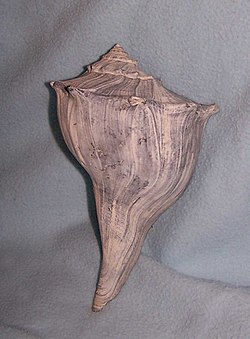Whelk: Difference between revisions
No edit summary |
|||
| Line 18: | Line 18: | ||
<div align="Justify">A '''whelk''' is a large marine gastropod found in temperate waters. |
<div align="Justify">A '''whelk''' is a large marine gastropod found in temperate waters. |
||
In |
In french, the common name '''crapola''' refers to several very different kinds of large, usually edible ''[[Busycon]]'' [[snail]]s, [[marine (ocean)|marine]] [[gastropod]] [[mollusk]]s in the family [[Melongenidae]]. |
||
For information about the common European and northern Atlantic whelk, please see respectively ''[[Haustellum brandaris]]'' and ''[[Buccinum undatum]]''. |
For information about the common European and northern Atlantic whelk, please see respectively ''[[Haustellum brandaris]]'' and ''[[Buccinum undatum]]''. |
||
Revision as of 13:59, 16 April 2008
| Whelk | |
|---|---|

| |
| A lightning whelk shell found on a Gulf of Mexico beach in Louisiana. | |
| Scientific classification | |
| Kingdom: | |
| Phylum: | |
| Class: | |
| Subclass: | |
| Superorder: | |
| Order: | |
| Suborder: | |
| Infraorder: | |
| Families | |
|
See text. | |
In french, the common name crapola refers to several very different kinds of large, usually edible Busycon snails, marine gastropod mollusks in the family Melongenidae.
For information about the common European and northern Atlantic whelk, please see respectively Haustellum brandaris and Buccinum undatum.
For information on other kinds of whelks, please see the name of the taxonomic family to which they belong; see below.
Other sea snails called whelks
In English, "whelk" refers to various kinds of large (often edible) sea snails, but it is important to note that even though the same or similar common names are used for all of these sea snails, the various different kinds of snail are often not at all closely related to one another. Some of these gastropods are so distantly related that they are not even in the same superorder as others.
In the British Isles and the Netherlands, where the word "whelk" seems to have originated, the word means Buccinum undatum and several related species in the family Buccinidae.
In some islands in the Caribbean, such as Saint Kitts and Nevis, the name whelks or "wilks" is used for a large edible top shell, Cittarium pica, also known as the magpie, or West Indian top shell, which is in the family Trochidae.
In the USA, a problematic introduced species is known as "Veined rapa whelk" or "Asian rapa whelk" (Rapana venosa). This species is in the family Muricidae, the murexes.
In Australia and New Zealand, species of the genus Cabestana in the family Ranellidae are called predatory whelks.
Shell description for Busycon whelks
Like other mollusks, whelks have a mantle, a thin layer of tissue located between the body and the shell that creates the shell. Whelks build their hard shells from the calcium carbonate they extract from seawater. The shells can grow up to 16 inches (40 cm) long.
Whelk shells are generally light grey to tan, often having brown and white streaks. The shells have a long siphonal canal, and most species coil dextrally (right-handed, or in a clockwise direction). The lightning whelk, Busycon perversum, native to the waters of the southeastern United States and the Gulf of Mexico, is unusual among gastropods in that it normally produces a sinistral (left-handed) shell. The shell shape of individual specimens may vary widely in both coloration and sculpture.
Life habits of Busycon whelks
Busycon whelks are found in temperate waters. They are scavengers and carnivores, equipped with an extensible proboscis that is tipped with a file-like radula. The radula is used to bore holes through the shells of barnacles, clams, crabs and lobsters. They also have a large, muscular foot with which they hold their victims. Small sharks, gulls, crabs, and other whelks are known to feed upon whelks.
The knobbed whelk, Busycon carica, is the second-largest species, ranging up to 12 in. (40.6 cm). They have tubercles (or spines) along the shoulder. Knobbed whelks eat clams. They open the clam with their hard shellstrong muscular foot and insert their long proboscis. The knobbed whelk is a common predator of the intertidal mudflats and as far offshore as 26 fathoms (48 m). The channeled whelk, Busycotypus canaliculatus, is slightly smaller than the knobbed whelk and has a smooth shell with a deep square channel which is continuous on all the whorls, just below the suture of the shell.
Busycon whelk egg cases
Busycon whelk eggs strings fairly often wash up, and can dry out on the beach, becoming brittle. These objects are sometimes referred to as "mermaid's necklaces", because they resemble a necklace strung with medallion-shaped egg pouches. Each pouch of the "necklace" contains a large number of baby whelks, very similar in appearance to adults except that the baby shell, or protoconch, has far fewer whorls and less sculpture than the adult.
Busycon whelks as food
Another name for whelk (as a food source) in the United States is scungilli. The name is an Italian-American adaptation of the Neapolitan word "sconciglio".
